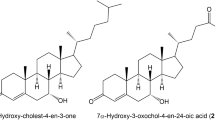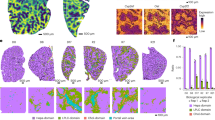Abstract
Membrane-associated cytotoxicity induced by hydrophobic bile salts is a major contributing factor leading to liver diseases. Administration of ursodeoxycholate reduces serum liver enzymes in chronic liver diseases but the nature of this effect is still unclear. Using alcohol metabolising enzymes as cellular markers, the hepatotoxic properties of hydrophobic bile salts and the putative hepatoprotective effect of ursodeoxycholate was examined. Two animal models of biliary retention, bile duct obstruction and choledochocaval fistula was used to investigate the effect of taurocholate on the hepatic alcohol metabolizing enzymes: cytosolic alcohol dehydrogenase, microsomal ethanol oxidizing system, catalase and aldehyde dehydrogenase before and after the infusion of taurocholic acid or tauroursodeoxycholic acid for two days period. Bile duct obstruction was found to be similar to or slightly exceeds choledochocaval fistula in the degree of retention. Following the taurocholic acid infusion, the serum alcohol dehydrogenase activity as well as microsomal ethanol oxidizing system and aldehyde dehydrogenase were greatly increased but the level of cytosolic alcohol dehydrogenase and catalase activities was found to be lower in either or both models in comparison with the control animals. However, the tauroursodeoxycholic acid infusion did not induce any significant changes in the levels of all the alcohol metabolizing enzyme activities in either or both models. These findings suggest that hydrophobic taurocholic acid(7α) affects the plasmalemma to allow leakage of cytosolic alcohol dehydrogenase into the blood circulation, stimulates the biosynthesis of microsomal ethanol oxidizing system and aldehyde dehydrogenase, and suppresses the biosynthesis of alcohol dehydrogenase and catalase. But in contrast, the hydrophilic tauroursodeoxycholic acid (7β) provided hepatoprotective effect.
Similar content being viewed by others
Article PDF
Author information
Authors and Affiliations
Rights and permissions
This is an Open Access article distributed under the terms of the Creative Commons Attribution Non-Commercial License (http://creativecommons.org/licenses/by-nc/3.0/) which permits unrestricted non-commercial use, distribution, and reproduction in any medium, provided the original work is properly cited.
About this article
Cite this article
Kim, Y., Shin, M. Effects of high taurocholate load on activities of hepatic alcohol metabolizing enzymes. Exp Mol Med 34, 123–130 (2002). https://doi.org/10.1038/emm.2002.18
Published:
Issue date:
DOI: https://doi.org/10.1038/emm.2002.18



